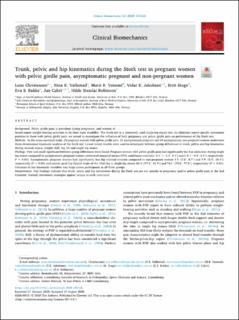Trunk, pelvic and hip kinematics during the Stork test in pregnant women with pelvic girdle pain, asymptomatic pregnant and non-pregnant women
Christensen, Lene; Vøllestad, Nina Køpke; Veierød, Marit Bragelien; Jakobsen, Vidar Eivind; Stuge, Britt; Bakke, Eva; Cabri, Jan Maria Hendrick; Robinson, Hilde Stendal
Peer reviewed, Journal article
Published version

Permanent lenke
https://hdl.handle.net/11250/2734577Utgivelsesdato
2020Metadata
Vis full innførselSamlinger
- Artikler / Articles [2119]
- Publikasjoner fra Cristin [1107]
Sammendrag
Background: Pelvic girdle pain is prevalent during pregnancy, and women affected report weight-bearing activities to be their main disability. The Stork test is a commonly used single-leg-stance test. As clinicians report specific movement patterns in those with pelvic girdle pain, we aimed to investigate the influence of both pregnancy and pelvic girdle pain on performance of the Stork test.
Methods: In this cross-sectional study, 25 pregnant women with pelvic girdle pain, 23 asymptomatic pregnant and 24 asymptomatic non-pregnant women underwent three-dimensional kinematic analysis of the Stork test. Linear mixed models were used to investigate between-group differences in trunk, pelvic and hip kinematics during neutral stance, weight shift, leg lift and single leg stance.
Findings: Few and small significant between-group differences were found. Pregnant women with pelvic girdle pain had significantly less hip adduction during single leg stance compared to asymptomatic pregnant women (estimated marginal means (95% confidence intervals) -1.1° (−2.4°, 0.3°) and 1.0° (−0.4°, 2.4°), respectively; P = 0.03). Asymptomatic pregnant women had significantly less hip internal rotation compared to non-pregnant women 4.1° (1.6°, 6.7°) and 7.9° (5.4°, 10.4°), respectively (P = 0.04) and greater peak hip flexion angle of the lifted leg in single leg stance 80.4° (77.0°, 83.9°) and 74.1° (70.8°, 77.5°), respectively (P = 0.01). Variation in key kinematic variables was large across participants in all three groups.
Interpretation: Our findings indicate that trunk, pelvic and hip movements during the Stork test are not specific to pregnancy and/or pelvic girdle pain in the 2nd trimester. Instead, movement strategies appear unique to each individual.
Beskrivelse
This is an open access article under the CC BY license (http://creativecommons.org/licenses/by/4.0/).
Tidsskrift
Clinical BiomechanicsOpphavsrett
© 2020 The AuthorsBeslektede innførsler
Viser innførsler beslektet ved tittel, forfatter og emneord.
-
Kinematic and spatiotemporal gait characteristics in pregnant women with pelvic girdle pain, asymptomatic pregnant and non-pregnant women
Christensen, Lene; Veierød, Marit Bragelien; Vøllestad, Nina Køpke; Jakobsen, Vidar Eivind; Stuge, Britt; Cabri, Jan; Robinson, Hilde Stendal (Peer reviewed; Journal article, 2019)Background Walking difficulties are common among pregnant women with pelvic girdle pain. This cross-sectional study investigated the influence of pelvic girdle pain, pregnancy and speed on spatiotemporal and trunk, pelvic ... -
The Timed Up & Go test in pregnant women with pelvic girdle pain compared to asymptomatic pregnant and non-pregnant women
Christensen, Lene; Vøllestad, Nina Køpke; Veierød, Marit Bragelien; Stuge, Britt; Cabri, Jan; Robinson, Hilde Stendal (Peer reviewed; Journal article, 2019)Background: The Timed Up and Go (TUG) test, a standardized functional mobility test, has been proposed as aphysical performance-based measure in pregnant women with pelvic girdle pain (PGP).Objectives:This cross-sectional ... -
Effect of a regular exercise programme on pelvic girdle and low back pain in previously inactive pregnant women: a randomized controlled trial
Haakstad, Lene Annette Hagen; Bø, Kari (Journal article; Peer reviewed, 2014)OBJECTIVE: To determine whether participation in a group fitness class for pregnant women can prevent and treat pelvic girdle pain and low back pain. DESIGN: An observer-blinded randomized controlled trial. PARTICIPANTS: ...